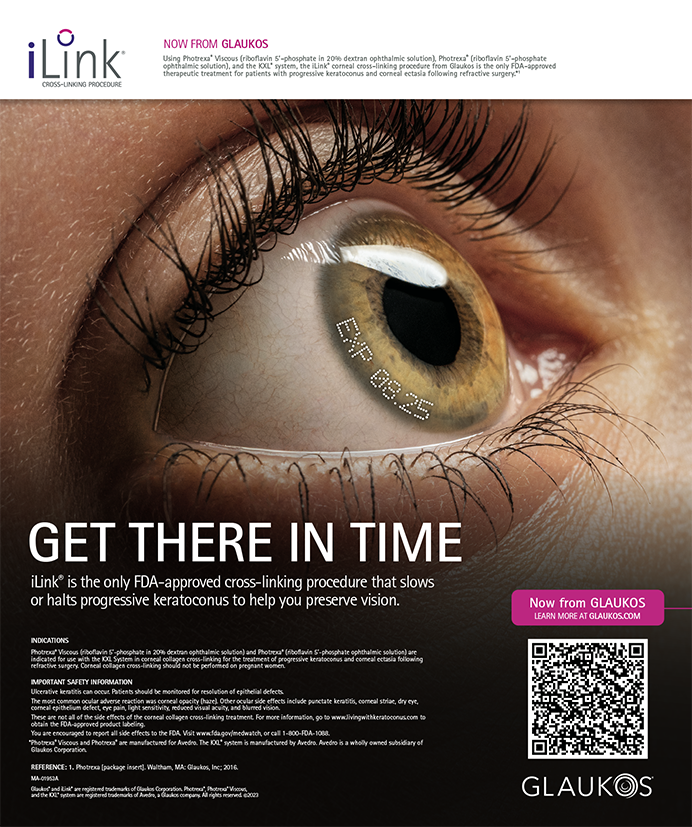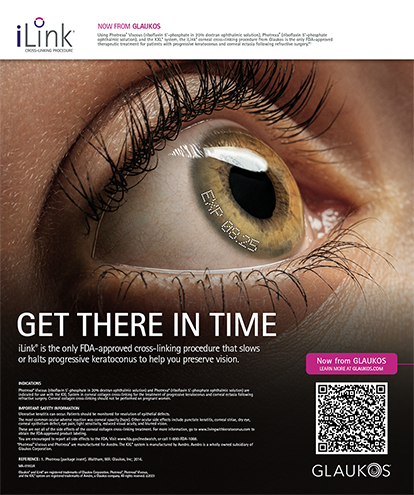Dimple-Down Maneuver
By Lisa Brothers Arbisser, MD
Not long ago, I began performing laser cataract surgery. One of its main advantages is the elegant, reproducible astigmatic keratotomy. Time will tell if the reproducible anterior capsulotomy will make a long-term difference in refraction and stability, because there is some evidence that the opening shrinks less.1 Regardless of technique, a continuous edge to the capsulotomy is critical to avoid complications, and cataract surgeons must approach every case as though there could be a bridge or tag, although this occurrence is becoming increasingly rare. In its handbook that comes with the laser system, the FDA states that it requires a capsulorhexis-like step to remove the flap, but I have added a central dimple-down maneuver, as will be described.2
After administering preservative-free lidocaine solution through a paracentesis, I instill a homogeneous fill of an ophthalmic viscosurgical device (OVD) to maintain the anterior chamber. I then pass the OVD cannula through the main incision, advance it to the middle of the lens capsule, and press its tip down at the center of the capsule. This downward motion indents the capsular disc, pulls it gently centrally, separates the free edge from the surrounding peripheral capsule, and confirms the presence of a continuous 360º cut with a free flap (Figure). If a tag is present, this maneuver will identify its location and usually “pop” it free without causing a radial tear. Next, I remove the free disc with a circular capsulorhexis-like technique for a belt and suspenders and to comply with the FDA’s policy.
The dimple-down maneuver applies forces similar to those recommended by Brian Little, FRCS, FRCOphth, for managing an errant tear during a manual capsulorhexis: controlling the chamber with an OVD, folding the capsular flap back into its original position (the native state in a laser case), and applying traction in the horizontal plane of the capsule (what the cannula’s downward motion achieves). With a manual capsulorhexis, the advice is to pull backward and downward in the direction of the completed tear. With a laser capsulotomy, the surgeon does not know what direction the base of the laser tag has taken—hence the central dimple down. I have encountered no capsular breaks since adopting this technique.
Lisa Brothers Arbisser, MD, is in private practice with Eye Surgeons Assoc. PC, located in the Iowa and Illinois Quad Cities. Dr. Arbisser is also an adjunct associate professor at the John A. Moran Eye Center of the University of Utah in Salt Lake City. She is on the speakers’ bureau of Abbott Medical Optics Inc. as well as OptiMedica Corporation’s surgeons’ counsel. Dr. Arbisser may be reached at (563) 323-2020; drlisa@arbisser.com.
- Culbertson WW. Anterior capsule healing patterns following femtosecond laser-assisted cataract surgery. Paper presented at: ASCRS Symposium on Cataract, IOL and Refractive Surgery; April 20-24, 2012; Chicago, IL.
- Arbisser LB, Schultz T, Dick HB. Central dimple-down maneuver for consistent continuous femtosecond laser capsulotomy. J Cataract Refract Surg. 2013;39(12):1796-1797.
Closure of the Incision
By Kevin M. Miller, MD
I pay much more attention to the milieu in which I close the incision now than I ever did before. Continuous irrigation through the eye during phacoemulsification, cortical removal, and the viscoelastic’s removal virtually ensures that microbes introduced during surgery are washed out of the eye. Bugs introduced when the incisions are hydrated or the anterior chamber is reformed, however, remain. Most eyes can clear a small inoculum of bacteria, especially if they are unduly inflamed after surgery, but it is better to leave the anterior chamber as sterile as possible.
There is usually a cesspool of lipid- and microbe-laden fluid all around the incision at the end of cataract surgery. Before closing, I now meticulously dry the conjunctival surface and the limbus with sterile Weck-Cel sponges (Beaver-Visitec International), especially the area around the primary and paracentesis incisions (Figure). I also flush the 30-gauge cannula before I hydrate the incisions or reform the anterior chamber.
I believe that sterilely sealing the incision would render unnecessary the povidone-iodine prep and postoperative antibiotics we surgeons all use routinely.
Kevin M. Miller, MD, is the Kolokotrones professor of clinical ophthalmology at the David Geffen School of Medicine at UCLA, Jules Stein Eye Institute, in Los Angeles. He acknowledged no financial interest in the product or company he mentioned. Dr. Miller may be reached at (310) 206-9951; kmiller@ucla.edu.
Three-dimensional Video
By Richard J. Mackool, MD, and Richard J. Mackool Jr, MD
In 2013, a Sony 3D video recorder and display monitor (Sony Electronics Inc.) were installed at our ambulatory surgery center in Astoria, New York. We expected that using the three-dimensional (3-D) recordings during our presentations at medical meetings would be greatly appreciated by our audience, and we wanted to be able to demonstrate the surgical techniques and technologies that we favor just as if the observers were viewing them through their own microscopes. We have shown the videos at several meetings this year, and the attendees’ ratings of the recordings’ value were universally favorable.
We hoped that the many surgeons who visit our center would benefit as well, and this has also proven to be the case. Several physicians can comfortably and simultaneously observe procedures without using the assistant microscope. We have actually found the stereopsis provided by the Sony system to be far superior to that provided by the assistant microscope.
We can envision a day when it will be possible to stream 3-D educational videos to a suitably equipped personal computer and when live operative events can be transmitted so as to obtain consultations during a procedure.
In our experience, everyone enjoys watching procedures in 3-D. Viewing these recordings has dramatically increased our professional staff’s understanding of our work; it appears to have stimulated their curiosity as well as their pride in being a part of our surgical team. Personally, we are keenly aware that the sheer elegance of the system enhances the air of technological sophistication in the OR. We love this technology!
Richard J. Mackool, MD, is the director of the Mackool Eye Institute and Laser Center in Astoria, New York. He acknowledged no financial interest in the product or company he mentioned. Dr. Mackool may be reached at (718) 728-3400, ext 256; mackooleye@aol.com.
Richard J. Mackool Jr, MD, is the assistant director of the Mackool Eye Institute and Laser Center in Astoria, New York. He acknowledged no financial interest in the product or company he mentioned. Dr. Mackool may be reached at (718) 728-3400, ext. 256; mackooleye@aol.com.


